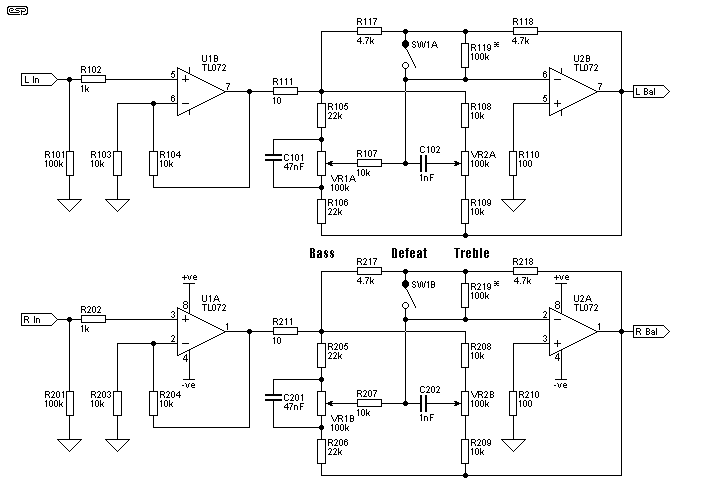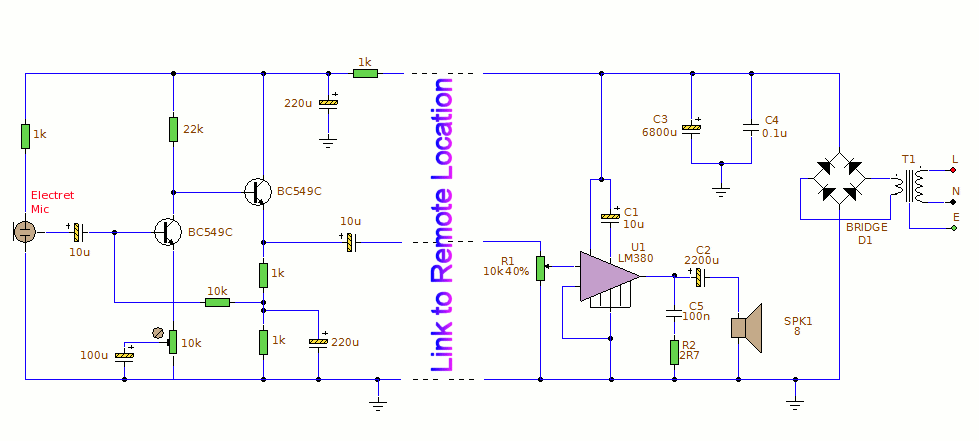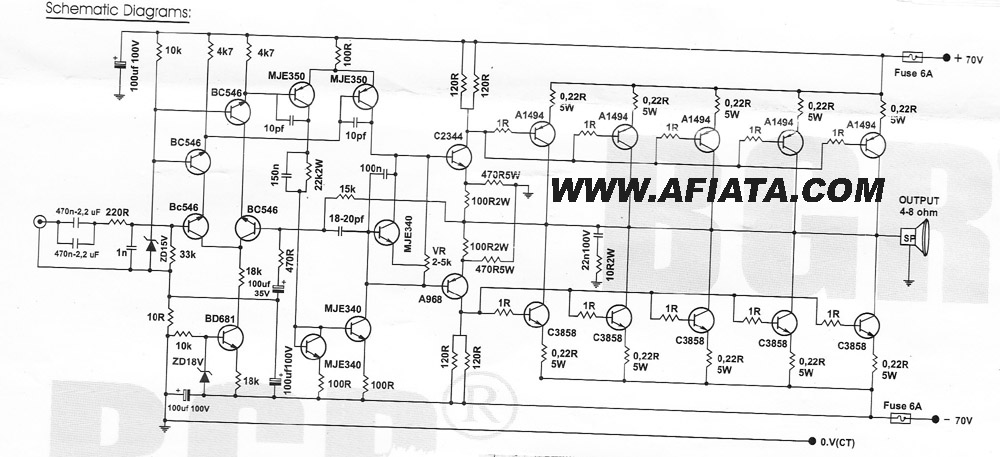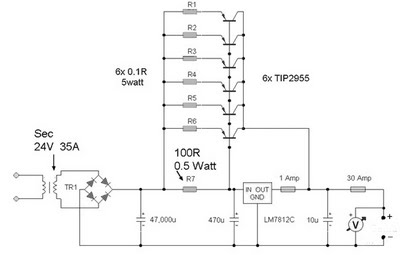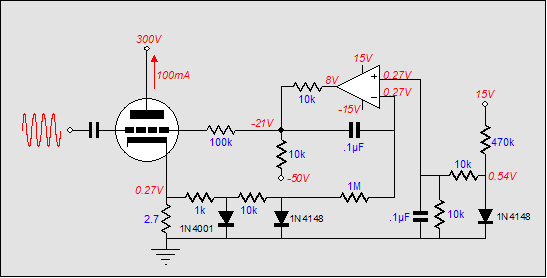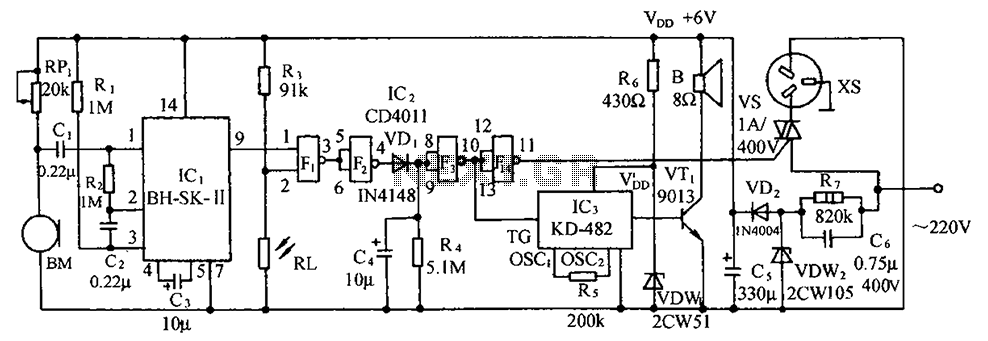
BiQuad Filter Circuit Diagram using LM3403 Quad Op Amp
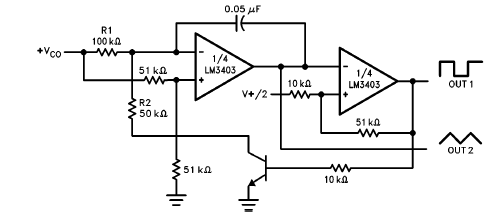
The LM3403 op-amp family includes the LM3303, which is a monolithic quad op-amp known for its high gain. It features a compensated internal frequency, allowing it to operate effectively across a wide range of voltages from both single and dual power supplies. The provided circuit diagram illustrates a biquad filter utilizing the LM3403 quad op-amp. The design operates at a center frequency of 1000 Hz, with a bandwidth of 100 W, a center frequency gain (TBP) of 1, and a bandpass notch gain (TN) of 1. The resistor values are R = 160 kOhm, R1, R2, and R3 are 1.6 MOhm, and the capacitor value is C = 0.001 µF. The quality factor (Q) is calculated as BW/fo, where fo = 1/(2πRC). The reference voltage (VREF) is set to 0.5 * Vcc, R1 is determined as Q * R, R2 as R1/TBP, R3 as TN * R2, and C1 is equal to 10 * C.
The LM3403 op-amp family, particularly the LM3303 model, is designed for applications requiring high precision and stability. The monolithic structure contributes to reduced noise and improved performance in signal processing tasks. The biquad filter circuit depicted in the schematic utilizes the quad op-amp's capabilities to achieve a specific frequency response characterized by a center frequency of 1000 Hz.
In this configuration, the bandwidth of 100 W indicates the range of frequencies that the filter will allow to pass through, while the center frequency gain (TBP) and bandpass notch gain (TN) being set to 1 imply that the filter will neither amplify nor attenuate the signal at the center frequency and notch frequencies, respectively.
The resistors and capacitors in the circuit are critical in defining the filter's characteristics. The resistor R, valued at 160 kOhm, works in conjunction with R1, R2, and R3 (each 1.6 MOhm) to set the gain and frequency response. The capacitor C, valued at 0.001 µF, plays a vital role in determining the cutoff frequencies and the overall behavior of the filter. The calculations for Q and fo are essential for ensuring that the filter meets the desired specifications.
The reference voltage VREF, set to half of the supply voltage (0.5 * Vcc), provides a stable operating point for the op-amps, ensuring linear operation within the specified range. The relationships between the resistors, as defined by Q, TBP, and TN, allow for flexible tuning of the filter characteristics, making this configuration suitable for various signal processing applications in audio, communications, and control systems.This LM3403 op amp family including LM3303 known to be a monolithic quad op amp which have high gain, a compensated internal frequency that will assure a wide range of voltages can be operated from both single and/or dual power supply. The circuit diagram shown Bi Quad Filter using LM3403 Quad Op Amp. As you can see, it uses example that fo=1000Hz , BW=100W, TBP (center frequency gain)=1, TN (bandpass notch gain)=1, R=160 kOhm, R1/2/3=1. 6 MOhm, and C=0. 001uF; where Q= BW/fo, fo= 1/(2*phi*R*C) VREF=0. 5*Vcc, R1=Q*R, R2= R1/TBP, R3= TN*R2, and C1= 10*C. 🔗 External reference
The LM3403 op-amp family, particularly the LM3303 model, is designed for applications requiring high precision and stability. The monolithic structure contributes to reduced noise and improved performance in signal processing tasks. The biquad filter circuit depicted in the schematic utilizes the quad op-amp's capabilities to achieve a specific frequency response characterized by a center frequency of 1000 Hz.
In this configuration, the bandwidth of 100 W indicates the range of frequencies that the filter will allow to pass through, while the center frequency gain (TBP) and bandpass notch gain (TN) being set to 1 imply that the filter will neither amplify nor attenuate the signal at the center frequency and notch frequencies, respectively.
The resistors and capacitors in the circuit are critical in defining the filter's characteristics. The resistor R, valued at 160 kOhm, works in conjunction with R1, R2, and R3 (each 1.6 MOhm) to set the gain and frequency response. The capacitor C, valued at 0.001 µF, plays a vital role in determining the cutoff frequencies and the overall behavior of the filter. The calculations for Q and fo are essential for ensuring that the filter meets the desired specifications.
The reference voltage VREF, set to half of the supply voltage (0.5 * Vcc), provides a stable operating point for the op-amps, ensuring linear operation within the specified range. The relationships between the resistors, as defined by Q, TBP, and TN, allow for flexible tuning of the filter characteristics, making this configuration suitable for various signal processing applications in audio, communications, and control systems.This LM3403 op amp family including LM3303 known to be a monolithic quad op amp which have high gain, a compensated internal frequency that will assure a wide range of voltages can be operated from both single and/or dual power supply. The circuit diagram shown Bi Quad Filter using LM3403 Quad Op Amp. As you can see, it uses example that fo=1000Hz , BW=100W, TBP (center frequency gain)=1, TN (bandpass notch gain)=1, R=160 kOhm, R1/2/3=1. 6 MOhm, and C=0. 001uF; where Q= BW/fo, fo= 1/(2*phi*R*C) VREF=0. 5*Vcc, R1=Q*R, R2= R1/TBP, R3= TN*R2, and C1= 10*C. 🔗 External reference
